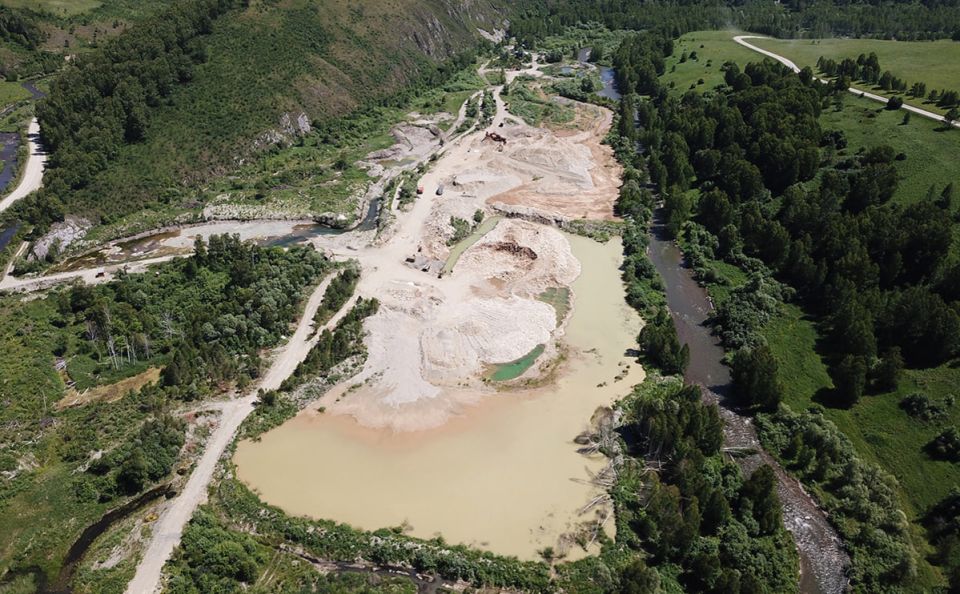Greed wins: gold miners massively pollute Russian rivers


In June, 231 cases of river pollution caused by suspended substances downstream from placer gold mining sites were documented on the Siberian and the Far East rivers. This pollution extended over 10,761 kilometres, as reported in an interim analysis by the Center for Satellite Monitoring and Civil Control (CSMiGK) available to the “Zolotari” project. Environmentalists describe it as the most extensive pollution from gold mining activities observed in recent years.
As mentioned by Kedr.Media and Alexander Kolotov, the satellite images decrypted and analyzed by CSMiGK specialists revealed that between June 1 and June 30, there were 105 cases of river pollution in the Amur region, spanning 3,352 kilometres; 43 cases in Krasnoyarsk Krai, covering 2,750 kilometres; 36 cases in the Kemerovo region, covering 2,909 kilometres; 27 cases in Zabaykalsky Krai, spanning 1,444 kilometres; 14 cases in the Jewish Autonomous Region, covering 266 kilometres; and 6 cases in Khabarovsk Krai, spanning 40 kilometres.
“The extensive nature of these environmental violations on the gold-bearing rivers of Siberia and the Far East clearly shows that greed is triumphing over nature, and the state has yet to counter this,” commented Alexander Kolotov, director of the “Conservation of Siberia and the Far East” foundation, regarding the satellite monitoring results. “If hundreds of gold mining licenses are issued each year without the ability to monitor their use, the outcome is predictable: isolated inspections and fines simply lose their effectiveness.”
Kolotov explained that as placer gold mining became highly profitable due to rising gold prices, gold miners largely ignored environmental restrictions, assuming that the potential profits would more than cover any fines. “This is why we see murky streams stretching downstream from gold mines for tens of kilometres almost without interruption in the satellite images,” noted the environmentalist. “This situation can only occur when gold mining waste is intentionally discharged into the river without regard for environmental oversight by the state.”
From May 15 (the start of satellite monitoring) to June 30, the Center for Satellite Monitoring and Civil Control recorded a total of 308 instances of river pollution with suspended substances downstream from placer gold mining sites, with the total length of identified pollution reaching 13,544 kilometres.

Also, it is important to heed this observation by environmentalists: “Murky streams extend downstream from gold mines for tens of kilometres almost uninterrupted,” as noted by the environmentalist. “This is only possible when gold mining waste is intentionally discharged into the river without any consideration for environmental oversight by the state.” Another significant statement is: “Gold miners have largely stopped complying with environmental regulations because they anticipate that potential profits will outweigh any fines.”
This means a long-term loss of drinking water and fish in these rivers for indigenous peoples. And not just during the years when gold mining cooperatives are active on the rivers, but for hundreds of years. Fish cannot reproduce in murky streams. As is well known, the fish stocks of Alaska’s gold-bearing rivers that do not flow into the sea have not recovered since the gold rush.
Therefore, it is no surprise that Rosprirodnadzor (Federal Service for Supervision of Natural Resources of the Russian Federation) imposed such a large fine on Norilsk Nickel, with the largest portion attributed to potential damage to aquatic biological resources.
It’s easier to deal with a large violator who is always in the public eye. But gold mining cooperatives are only fined small amounts, and only after the discovery of some pipe discharging waste into the river. This is one of thousands of such pipes. And it’s generally difficult to detect and prove the mass instances of machinery entering the rivers.
However, the Center for Satellite Monitoring and Civil Control has recorded hundreds of violations and thousands of kilometres of murky water in rivers downstream from licensed sites.
This is a serious reason for indigenous peoples, along with concerned local populations, to appeal to the Government and the State Duma with a demand to improve the relevant laws on placer gold mining. These laws should regulate the issuance of hundreds of licenses and prevent the mass pollution of rivers, which causes enormous and potentially long-term damage to aquatic biological resources and the nation’s food security.
Many regional indigenous organizations and local environmental groups from Murmansk to Kamchatka could support such a public initiative.
Category: Main, News Tags: far east, FPIC, gold mines, Jewish Autonomous Region, Khabarovsk, Krasnoyarsk, river pollution, russia, siberia, Zabaykalsk
One Comment on “Greed wins: gold miners massively pollute Russian rivers”
Copyright © 2025 · All Rights Reserved · Batani
Theme: Natural Lite by Organic Themes · RSS Feed
Hi there,
I am Sonam from Mongabay – Indigenous News Desk. I wanted to gather more information on the Gold mining impacting Russian rivers and Indigenous communities. Therefore, I was wondering if it is possible to get in touch with the relevant local sources for an interview. Please let me know.